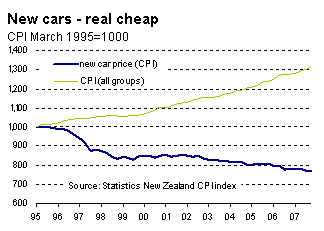Counting the cost of your car
As you stand at the petrol pump watching the dollars clicking over on the counter, think about what it’s really costing you to drive around in your car. It’s not the petrol. The big latent cost is depreciation – what you paid for your pride and joy will in many cases turn into a lot less when you come to sell it or trade it in. In very broad terms, fuel purchases account for around 10% of the total annual cost of owning and running a near-new car.
Over a three year period a new car is likely to lose between a third and a half of its value. When you churn through the figures you’ll find that that you burn through five to six times more in depreciation costs than in fuel per year. Depreciation ticks away all the time; it’s just not as obvious as forking out cash to fill-up every week. But while the cost of petrol is rising depreciation costs are dwindling.
There are other costs associated with owning and running a car – insurance, finance, repairs and maintenance, and registration (which has just gone up again). But whichever way you look at it, the big one is depreciation.
Depreciation reflects a number of factors but the obvious one is that the car simply wears out. Repairs and maintenance bills start to climb, it becomes less reliable and gets a few dings and some coffee stains.
But depreciation is also driven by obsolescence. One of the best current examples of this relates to another vital household item – your TV set. When you can only see 80% of what’s happening on your old square set you get the message that technology has marched on leaving your current TV basically redundant.
In the case of a car, your 1990 model will probably not have airbags, ABS, air conditioning a CD player, etc, etc – all features that are regarded as must-haves in most late model cars. So when you go to sell or trade-in your old car its value will be technologically challenged so to speak- it’s not only a little worn out, it’s patently obsolete.
Another factor that can have an important influence on what level of depreciation new car buyers must wear is what happens to new car prices over the time they own a car. If the price of a new car falls by say 10% over three years (Yeah Right, you might think, but read on) then clearly it would undermine what you could possibly get for the car you bought new three years earlier. This phenomenon was a fact of life in the mid-1990s as the government slashed tariffs on new cars and eventually removed them altogether. Declining new car prices led to much faster rates of new car depreciation and forced many traditional new car buyers to switch to the less punishing used car market, including used imports.
Thirteen years on, not only have depreciation rates slowed a bit, but also the real value of a new car has declined significantly leading to lower depreciation costs in real terms and certainly relative to peoples’ incomes. For instance, around 1995 a new mid-sized car might have set you back about $30,000. By 1998, with all tariffs removed, that same car brand new might have cost nearer $27,000. That’s another $3,000 added to the normal rate of depreciation which was somewhere around 25%pa. In round terms you would have wiped out as much as $17,000 in just three years.
Today that same type of car would probably cost you in the vicinity of $28,000 but would have a lot more bells and whistles; in other words you’d be getting a lot more for your money. The rate of depreciation has probably cooled a bit and new car prices are likely to remain more-or-less stable over the next three years. You’ll still lose around $15,000, but that’s less in nominal terms than the $17,000 you lost between 1995-98 on your new car, and when you adjust the numbers for inflation over the last 13 years the cost of depreciation in real terms is considerably smaller.

The fact is the upfront cost of buying a brand new car has fallen in nominal terms over the past 13 years and in real terms (taking into account quality improvements as well as inflation) the fall has been substantial – around 40%. This, together with milder rates of new car depreciation, is persuading buyers back into the new car market, which for the third successive year has recorded sales of more than 75,000.
While depreciation remains the major cost of car ownership, it’s a far lower cost relative to peoples’ incomes today than it was in 1995.In contrast, to buy 50 litres of petrol to fill your tank will require 3.6 hours work for somebody on the average wage compared to 2.9 hours back in 1995. Ouch! So despite the rise in the cost of refuelling your new car the overall cost of owning and running it continues to fall in real terms thanks to the decline in the rate of depreciation.






